International Marketing: Strategies and Market Analysis Report
VerifiedAdded on 2022/08/18
|14
|3084
|16
Report
AI Summary
This report provides a comprehensive overview of international marketing, beginning with a definition and highlighting the key differences between domestic and international marketing. It explores the adaptation of marketing strategies for various international markets, emphasizing the importance of understanding cultural differences and consumer behavior. The report then delves into market evaluation criteria, outlining factors such as environmental analysis, competition analysis, distribution analysis, and demand analysis. It also examines the application of the marketing mix (product, price, place, and promotion) in different international contexts, including examples of adaptation. The report further discusses various international marketing approaches, such as standardization and adaptation, and provides recommendations for organizational structuring to maximize opportunities in the international market. Finally, it emphasizes the need for a unified and holistic approach to international operations.
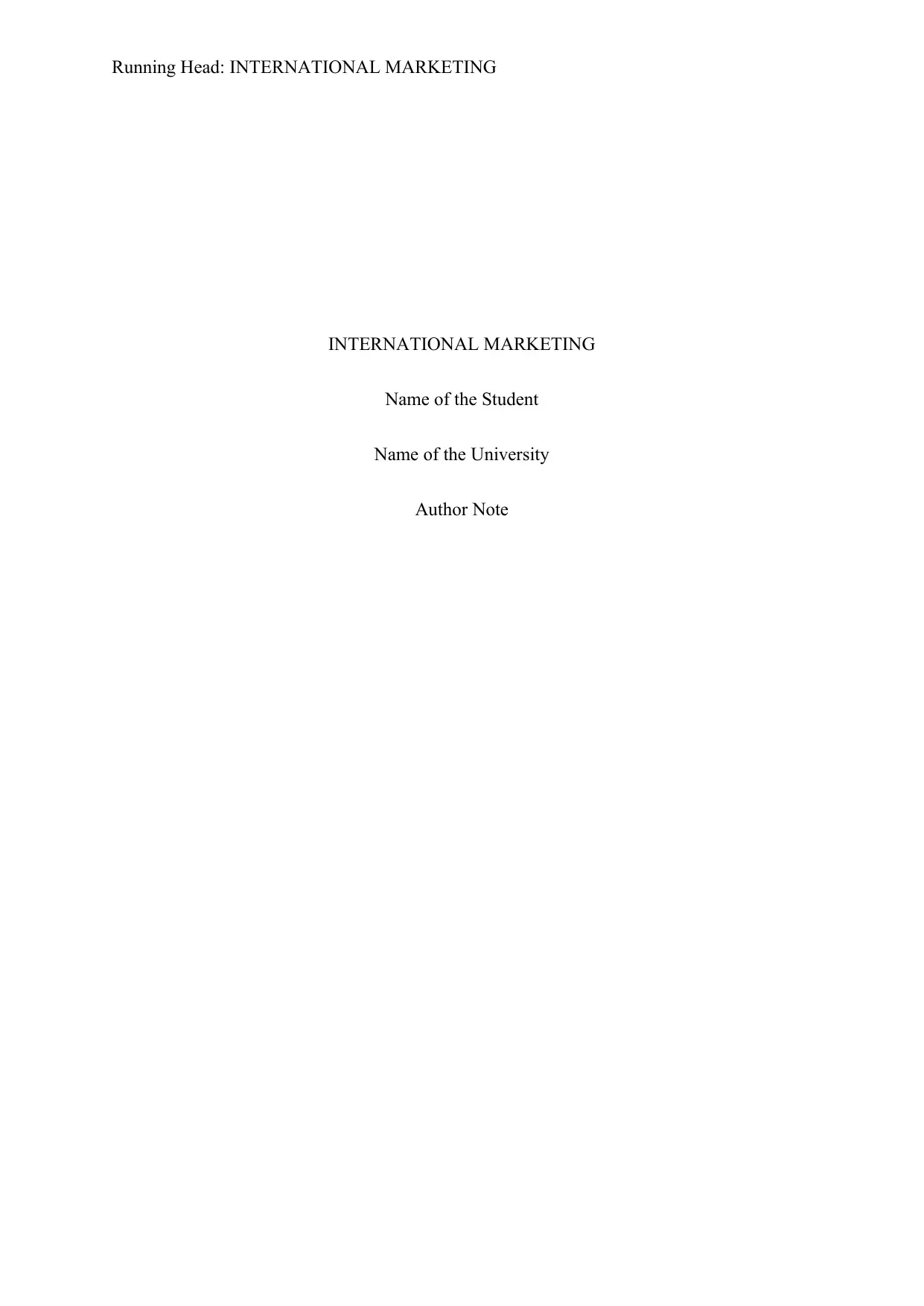
Running Head: INTERNATIONAL MARKETING
INTERNATIONAL MARKETING
Name of the Student
Name of the University
Author Note
INTERNATIONAL MARKETING
Name of the Student
Name of the University
Author Note
Paraphrase This Document
Need a fresh take? Get an instant paraphrase of this document with our AI Paraphraser
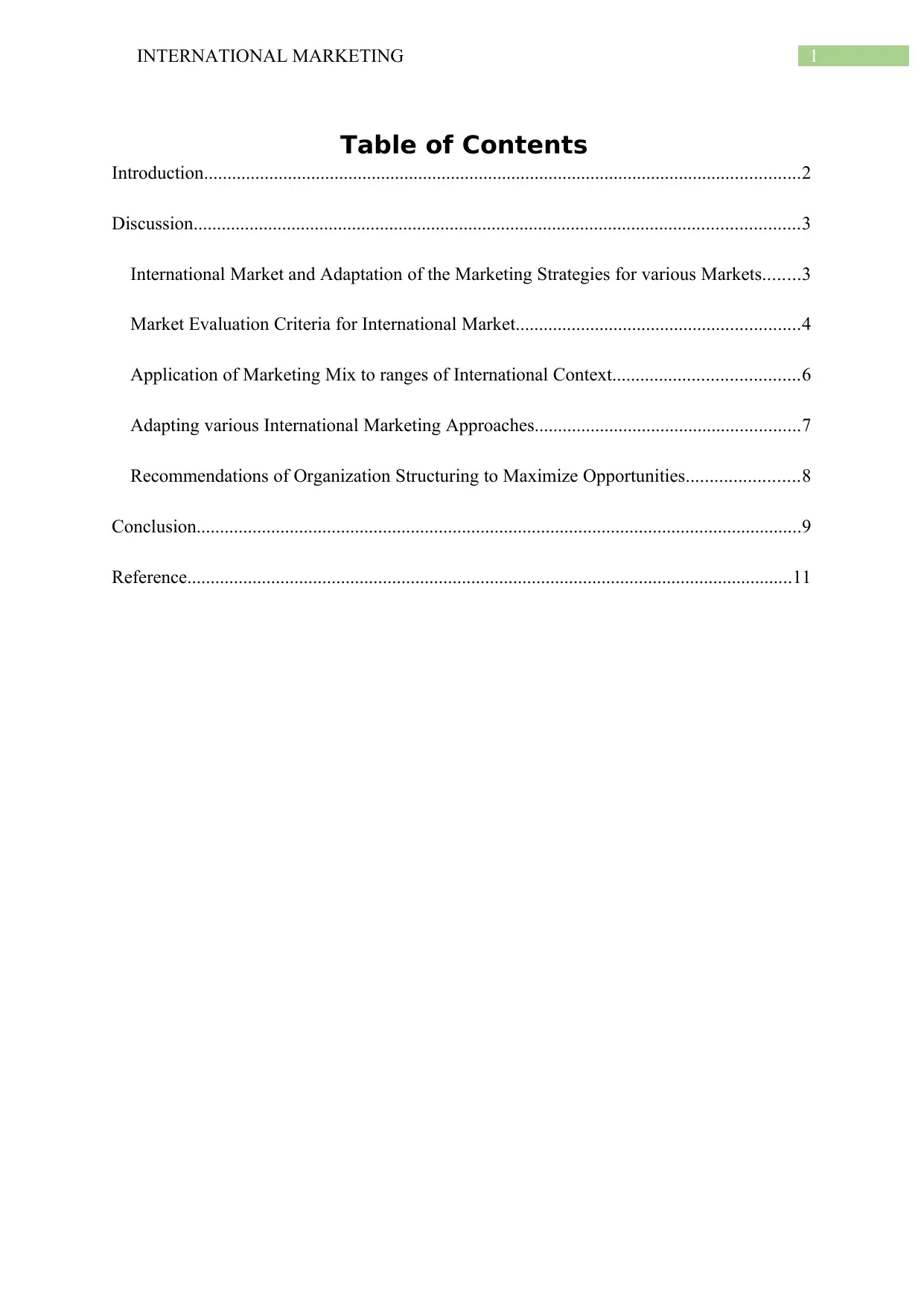
1INTERNATIONAL MARKETING
Table of Contents
Introduction................................................................................................................................2
Discussion..................................................................................................................................3
International Market and Adaptation of the Marketing Strategies for various Markets........3
Market Evaluation Criteria for International Market.............................................................4
Application of Marketing Mix to ranges of International Context........................................6
Adapting various International Marketing Approaches.........................................................7
Recommendations of Organization Structuring to Maximize Opportunities........................8
Conclusion..................................................................................................................................9
Reference..................................................................................................................................11
Table of Contents
Introduction................................................................................................................................2
Discussion..................................................................................................................................3
International Market and Adaptation of the Marketing Strategies for various Markets........3
Market Evaluation Criteria for International Market.............................................................4
Application of Marketing Mix to ranges of International Context........................................6
Adapting various International Marketing Approaches.........................................................7
Recommendations of Organization Structuring to Maximize Opportunities........................8
Conclusion..................................................................................................................................9
Reference..................................................................................................................................11
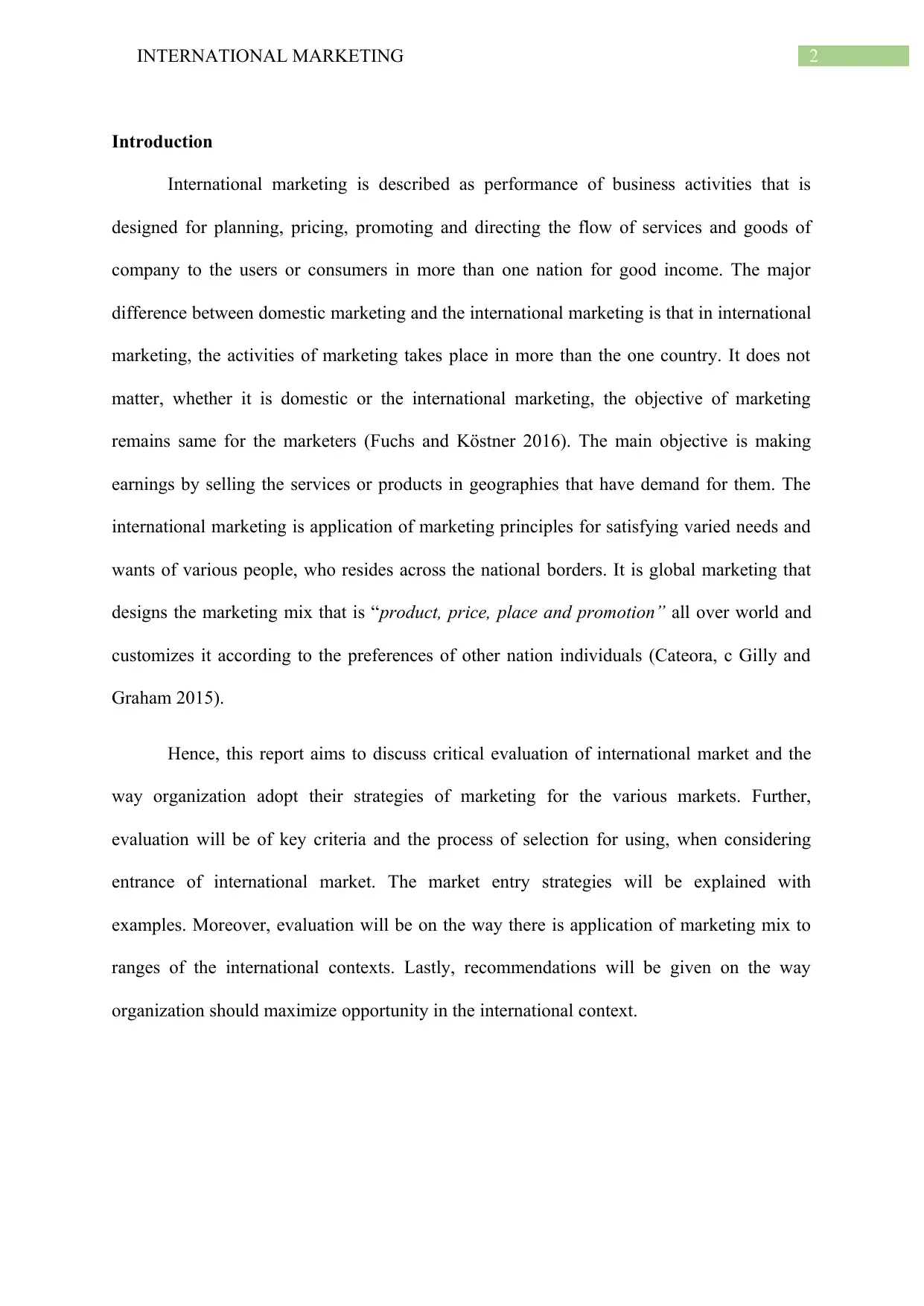
2INTERNATIONAL MARKETING
Introduction
International marketing is described as performance of business activities that is
designed for planning, pricing, promoting and directing the flow of services and goods of
company to the users or consumers in more than one nation for good income. The major
difference between domestic marketing and the international marketing is that in international
marketing, the activities of marketing takes place in more than the one country. It does not
matter, whether it is domestic or the international marketing, the objective of marketing
remains same for the marketers (Fuchs and Köstner 2016). The main objective is making
earnings by selling the services or products in geographies that have demand for them. The
international marketing is application of marketing principles for satisfying varied needs and
wants of various people, who resides across the national borders. It is global marketing that
designs the marketing mix that is “product, price, place and promotion” all over world and
customizes it according to the preferences of other nation individuals (Cateora, c Gilly and
Graham 2015).
Hence, this report aims to discuss critical evaluation of international market and the
way organization adopt their strategies of marketing for the various markets. Further,
evaluation will be of key criteria and the process of selection for using, when considering
entrance of international market. The market entry strategies will be explained with
examples. Moreover, evaluation will be on the way there is application of marketing mix to
ranges of the international contexts. Lastly, recommendations will be given on the way
organization should maximize opportunity in the international context.
Introduction
International marketing is described as performance of business activities that is
designed for planning, pricing, promoting and directing the flow of services and goods of
company to the users or consumers in more than one nation for good income. The major
difference between domestic marketing and the international marketing is that in international
marketing, the activities of marketing takes place in more than the one country. It does not
matter, whether it is domestic or the international marketing, the objective of marketing
remains same for the marketers (Fuchs and Köstner 2016). The main objective is making
earnings by selling the services or products in geographies that have demand for them. The
international marketing is application of marketing principles for satisfying varied needs and
wants of various people, who resides across the national borders. It is global marketing that
designs the marketing mix that is “product, price, place and promotion” all over world and
customizes it according to the preferences of other nation individuals (Cateora, c Gilly and
Graham 2015).
Hence, this report aims to discuss critical evaluation of international market and the
way organization adopt their strategies of marketing for the various markets. Further,
evaluation will be of key criteria and the process of selection for using, when considering
entrance of international market. The market entry strategies will be explained with
examples. Moreover, evaluation will be on the way there is application of marketing mix to
ranges of the international contexts. Lastly, recommendations will be given on the way
organization should maximize opportunity in the international context.
⊘ This is a preview!⊘
Do you want full access?
Subscribe today to unlock all pages.

Trusted by 1+ million students worldwide
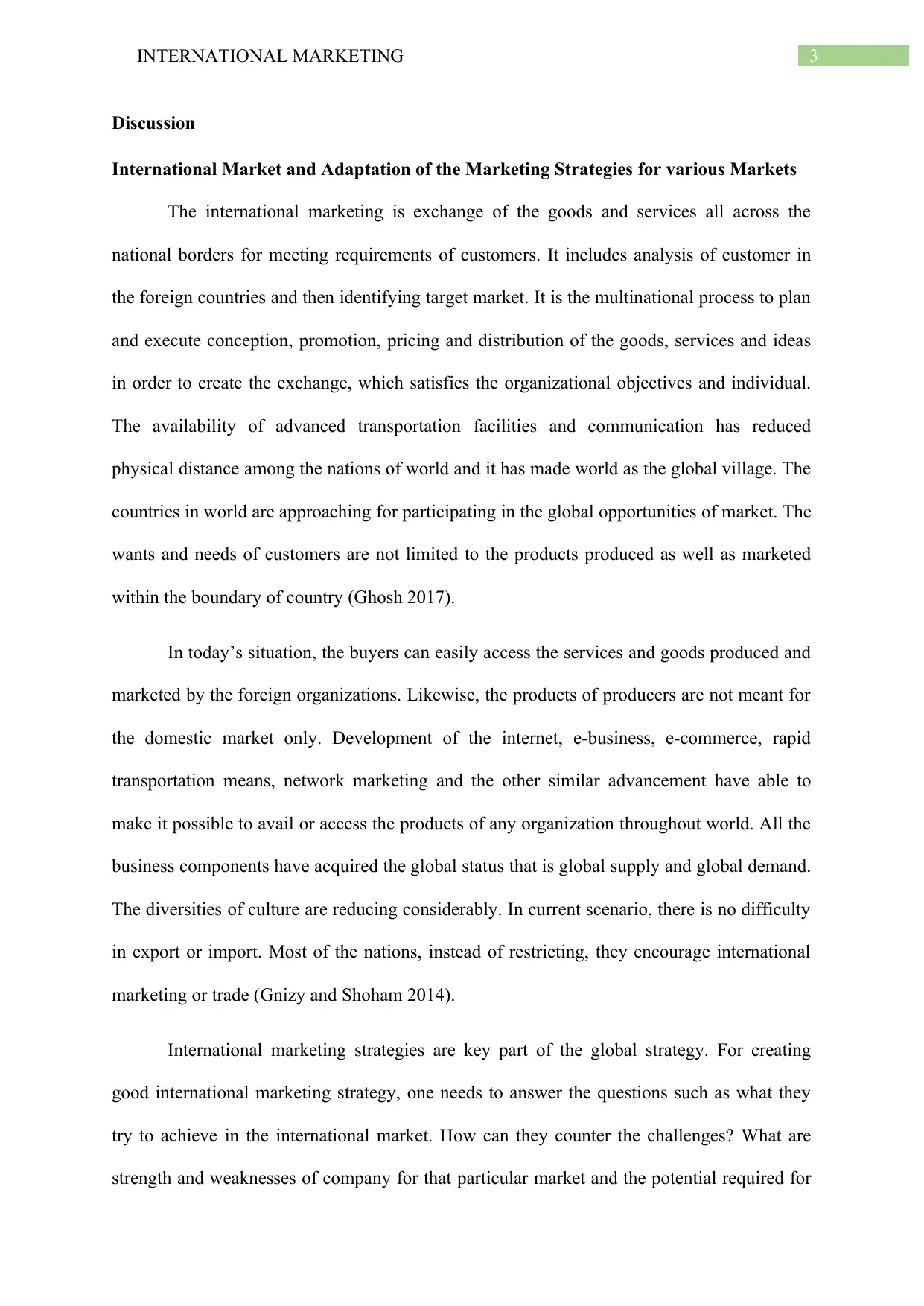
3INTERNATIONAL MARKETING
Discussion
International Market and Adaptation of the Marketing Strategies for various Markets
The international marketing is exchange of the goods and services all across the
national borders for meeting requirements of customers. It includes analysis of customer in
the foreign countries and then identifying target market. It is the multinational process to plan
and execute conception, promotion, pricing and distribution of the goods, services and ideas
in order to create the exchange, which satisfies the organizational objectives and individual.
The availability of advanced transportation facilities and communication has reduced
physical distance among the nations of world and it has made world as the global village. The
countries in world are approaching for participating in the global opportunities of market. The
wants and needs of customers are not limited to the products produced as well as marketed
within the boundary of country (Ghosh 2017).
In today’s situation, the buyers can easily access the services and goods produced and
marketed by the foreign organizations. Likewise, the products of producers are not meant for
the domestic market only. Development of the internet, e-business, e-commerce, rapid
transportation means, network marketing and the other similar advancement have able to
make it possible to avail or access the products of any organization throughout world. All the
business components have acquired the global status that is global supply and global demand.
The diversities of culture are reducing considerably. In current scenario, there is no difficulty
in export or import. Most of the nations, instead of restricting, they encourage international
marketing or trade (Gnizy and Shoham 2014).
International marketing strategies are key part of the global strategy. For creating
good international marketing strategy, one needs to answer the questions such as what they
try to achieve in the international market. How can they counter the challenges? What are
strength and weaknesses of company for that particular market and the potential required for
Discussion
International Market and Adaptation of the Marketing Strategies for various Markets
The international marketing is exchange of the goods and services all across the
national borders for meeting requirements of customers. It includes analysis of customer in
the foreign countries and then identifying target market. It is the multinational process to plan
and execute conception, promotion, pricing and distribution of the goods, services and ideas
in order to create the exchange, which satisfies the organizational objectives and individual.
The availability of advanced transportation facilities and communication has reduced
physical distance among the nations of world and it has made world as the global village. The
countries in world are approaching for participating in the global opportunities of market. The
wants and needs of customers are not limited to the products produced as well as marketed
within the boundary of country (Ghosh 2017).
In today’s situation, the buyers can easily access the services and goods produced and
marketed by the foreign organizations. Likewise, the products of producers are not meant for
the domestic market only. Development of the internet, e-business, e-commerce, rapid
transportation means, network marketing and the other similar advancement have able to
make it possible to avail or access the products of any organization throughout world. All the
business components have acquired the global status that is global supply and global demand.
The diversities of culture are reducing considerably. In current scenario, there is no difficulty
in export or import. Most of the nations, instead of restricting, they encourage international
marketing or trade (Gnizy and Shoham 2014).
International marketing strategies are key part of the global strategy. For creating
good international marketing strategy, one needs to answer the questions such as what they
try to achieve in the international market. How can they counter the challenges? What are
strength and weaknesses of company for that particular market and the potential required for
Paraphrase This Document
Need a fresh take? Get an instant paraphrase of this document with our AI Paraphraser
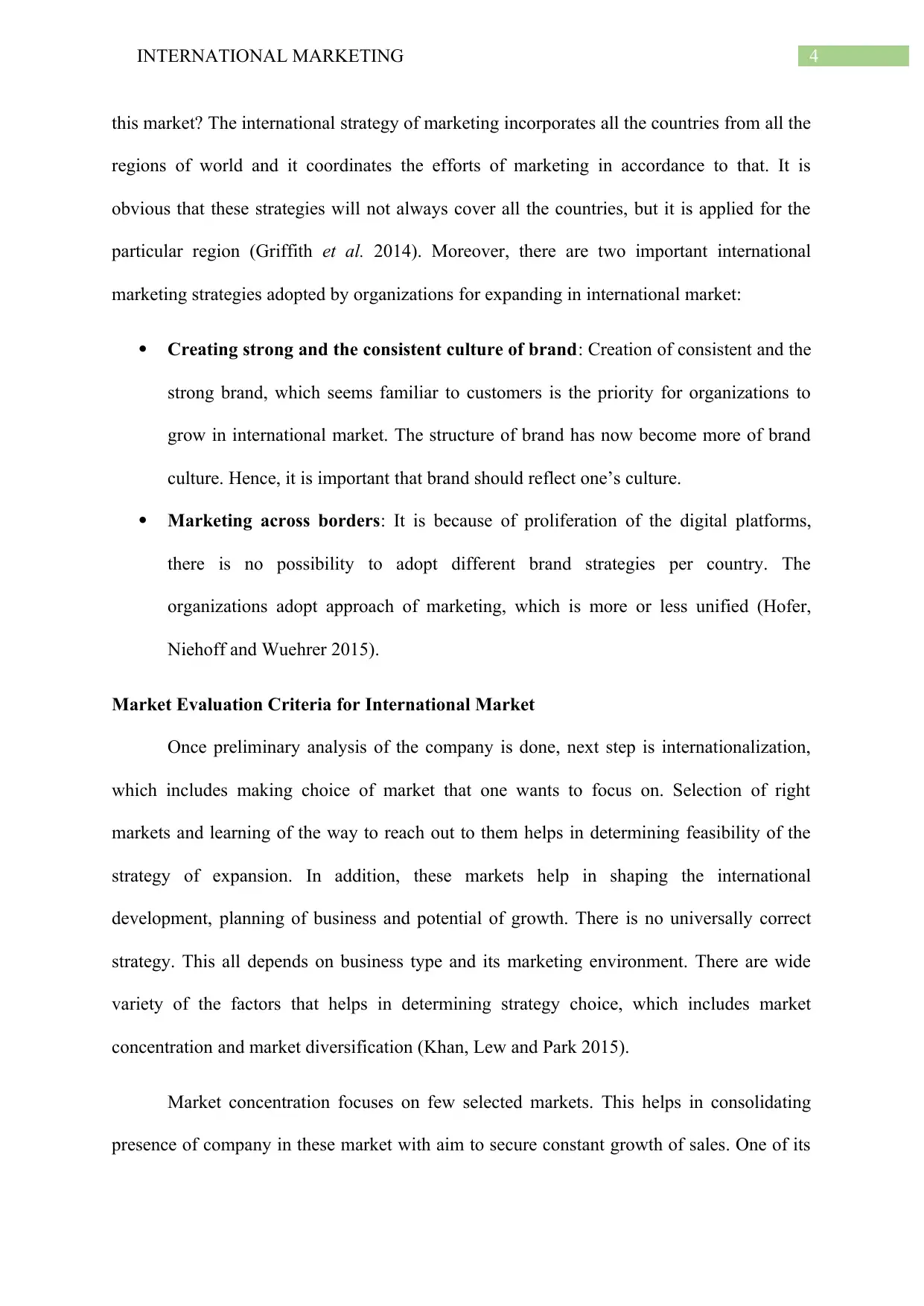
4INTERNATIONAL MARKETING
this market? The international strategy of marketing incorporates all the countries from all the
regions of world and it coordinates the efforts of marketing in accordance to that. It is
obvious that these strategies will not always cover all the countries, but it is applied for the
particular region (Griffith et al. 2014). Moreover, there are two important international
marketing strategies adopted by organizations for expanding in international market:
Creating strong and the consistent culture of brand: Creation of consistent and the
strong brand, which seems familiar to customers is the priority for organizations to
grow in international market. The structure of brand has now become more of brand
culture. Hence, it is important that brand should reflect one’s culture.
Marketing across borders: It is because of proliferation of the digital platforms,
there is no possibility to adopt different brand strategies per country. The
organizations adopt approach of marketing, which is more or less unified (Hofer,
Niehoff and Wuehrer 2015).
Market Evaluation Criteria for International Market
Once preliminary analysis of the company is done, next step is internationalization,
which includes making choice of market that one wants to focus on. Selection of right
markets and learning of the way to reach out to them helps in determining feasibility of the
strategy of expansion. In addition, these markets help in shaping the international
development, planning of business and potential of growth. There is no universally correct
strategy. This all depends on business type and its marketing environment. There are wide
variety of the factors that helps in determining strategy choice, which includes market
concentration and market diversification (Khan, Lew and Park 2015).
Market concentration focuses on few selected markets. This helps in consolidating
presence of company in these market with aim to secure constant growth of sales. One of its
this market? The international strategy of marketing incorporates all the countries from all the
regions of world and it coordinates the efforts of marketing in accordance to that. It is
obvious that these strategies will not always cover all the countries, but it is applied for the
particular region (Griffith et al. 2014). Moreover, there are two important international
marketing strategies adopted by organizations for expanding in international market:
Creating strong and the consistent culture of brand: Creation of consistent and the
strong brand, which seems familiar to customers is the priority for organizations to
grow in international market. The structure of brand has now become more of brand
culture. Hence, it is important that brand should reflect one’s culture.
Marketing across borders: It is because of proliferation of the digital platforms,
there is no possibility to adopt different brand strategies per country. The
organizations adopt approach of marketing, which is more or less unified (Hofer,
Niehoff and Wuehrer 2015).
Market Evaluation Criteria for International Market
Once preliminary analysis of the company is done, next step is internationalization,
which includes making choice of market that one wants to focus on. Selection of right
markets and learning of the way to reach out to them helps in determining feasibility of the
strategy of expansion. In addition, these markets help in shaping the international
development, planning of business and potential of growth. There is no universally correct
strategy. This all depends on business type and its marketing environment. There are wide
variety of the factors that helps in determining strategy choice, which includes market
concentration and market diversification (Khan, Lew and Park 2015).
Market concentration focuses on few selected markets. This helps in consolidating
presence of company in these market with aim to secure constant growth of sales. One of its
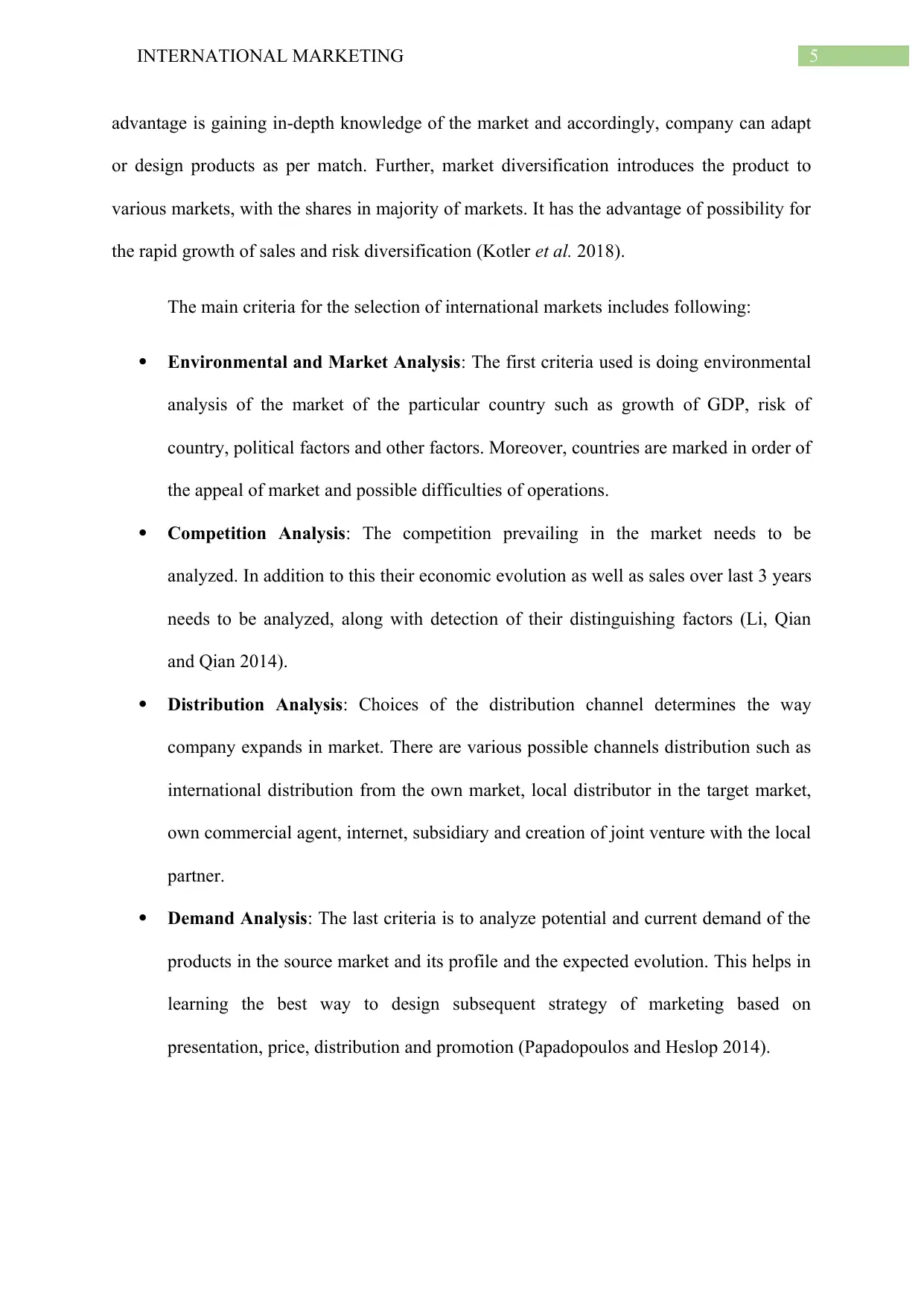
5INTERNATIONAL MARKETING
advantage is gaining in-depth knowledge of the market and accordingly, company can adapt
or design products as per match. Further, market diversification introduces the product to
various markets, with the shares in majority of markets. It has the advantage of possibility for
the rapid growth of sales and risk diversification (Kotler et al. 2018).
The main criteria for the selection of international markets includes following:
Environmental and Market Analysis: The first criteria used is doing environmental
analysis of the market of the particular country such as growth of GDP, risk of
country, political factors and other factors. Moreover, countries are marked in order of
the appeal of market and possible difficulties of operations.
Competition Analysis: The competition prevailing in the market needs to be
analyzed. In addition to this their economic evolution as well as sales over last 3 years
needs to be analyzed, along with detection of their distinguishing factors (Li, Qian
and Qian 2014).
Distribution Analysis: Choices of the distribution channel determines the way
company expands in market. There are various possible channels distribution such as
international distribution from the own market, local distributor in the target market,
own commercial agent, internet, subsidiary and creation of joint venture with the local
partner.
Demand Analysis: The last criteria is to analyze potential and current demand of the
products in the source market and its profile and the expected evolution. This helps in
learning the best way to design subsequent strategy of marketing based on
presentation, price, distribution and promotion (Papadopoulos and Heslop 2014).
advantage is gaining in-depth knowledge of the market and accordingly, company can adapt
or design products as per match. Further, market diversification introduces the product to
various markets, with the shares in majority of markets. It has the advantage of possibility for
the rapid growth of sales and risk diversification (Kotler et al. 2018).
The main criteria for the selection of international markets includes following:
Environmental and Market Analysis: The first criteria used is doing environmental
analysis of the market of the particular country such as growth of GDP, risk of
country, political factors and other factors. Moreover, countries are marked in order of
the appeal of market and possible difficulties of operations.
Competition Analysis: The competition prevailing in the market needs to be
analyzed. In addition to this their economic evolution as well as sales over last 3 years
needs to be analyzed, along with detection of their distinguishing factors (Li, Qian
and Qian 2014).
Distribution Analysis: Choices of the distribution channel determines the way
company expands in market. There are various possible channels distribution such as
international distribution from the own market, local distributor in the target market,
own commercial agent, internet, subsidiary and creation of joint venture with the local
partner.
Demand Analysis: The last criteria is to analyze potential and current demand of the
products in the source market and its profile and the expected evolution. This helps in
learning the best way to design subsequent strategy of marketing based on
presentation, price, distribution and promotion (Papadopoulos and Heslop 2014).
⊘ This is a preview!⊘
Do you want full access?
Subscribe today to unlock all pages.

Trusted by 1+ million students worldwide
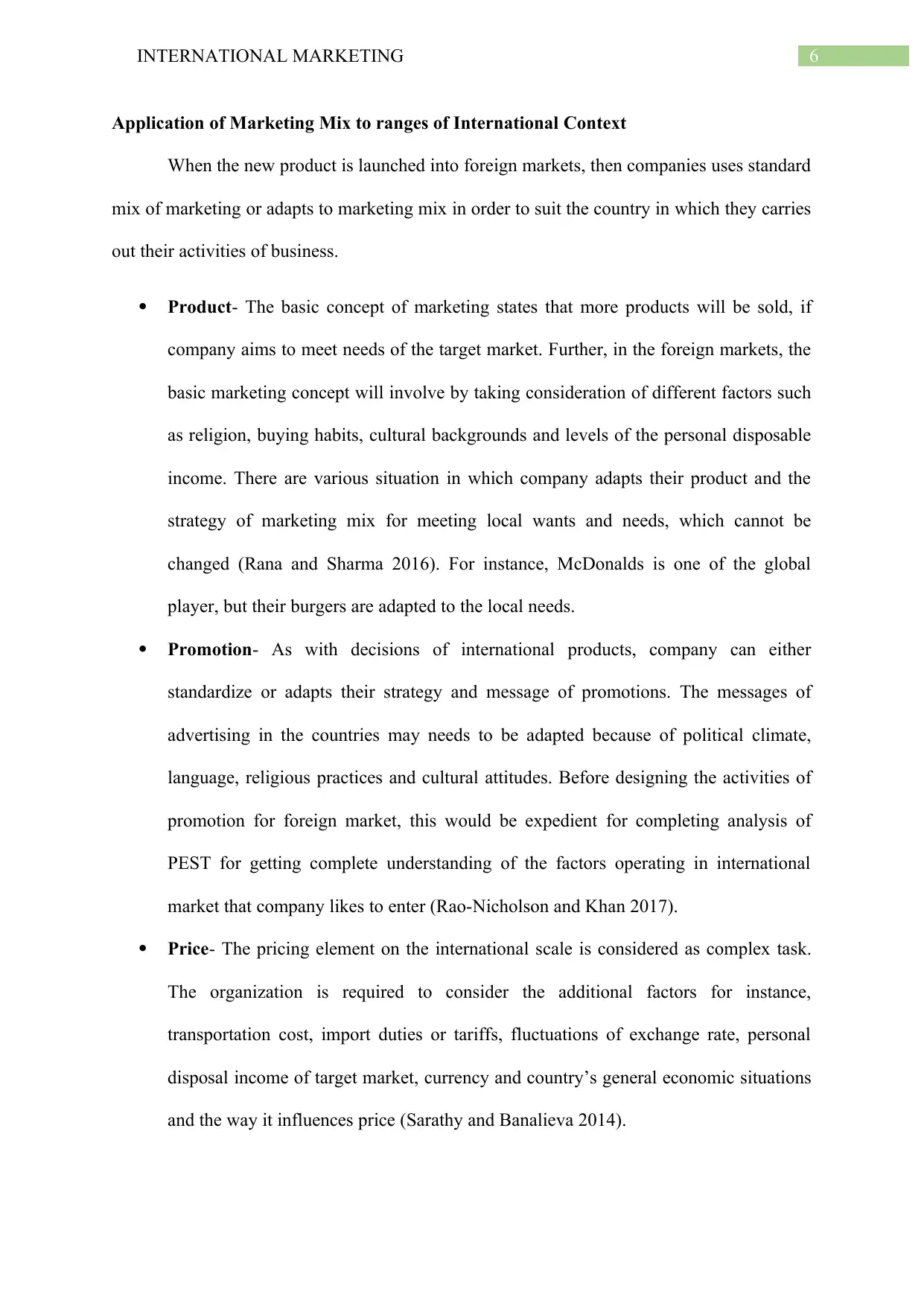
6INTERNATIONAL MARKETING
Application of Marketing Mix to ranges of International Context
When the new product is launched into foreign markets, then companies uses standard
mix of marketing or adapts to marketing mix in order to suit the country in which they carries
out their activities of business.
Product- The basic concept of marketing states that more products will be sold, if
company aims to meet needs of the target market. Further, in the foreign markets, the
basic marketing concept will involve by taking consideration of different factors such
as religion, buying habits, cultural backgrounds and levels of the personal disposable
income. There are various situation in which company adapts their product and the
strategy of marketing mix for meeting local wants and needs, which cannot be
changed (Rana and Sharma 2016). For instance, McDonalds is one of the global
player, but their burgers are adapted to the local needs.
Promotion- As with decisions of international products, company can either
standardize or adapts their strategy and message of promotions. The messages of
advertising in the countries may needs to be adapted because of political climate,
language, religious practices and cultural attitudes. Before designing the activities of
promotion for foreign market, this would be expedient for completing analysis of
PEST for getting complete understanding of the factors operating in international
market that company likes to enter (Rao-Nicholson and Khan 2017).
Price- The pricing element on the international scale is considered as complex task.
The organization is required to consider the additional factors for instance,
transportation cost, import duties or tariffs, fluctuations of exchange rate, personal
disposal income of target market, currency and country’s general economic situations
and the way it influences price (Sarathy and Banalieva 2014).
Application of Marketing Mix to ranges of International Context
When the new product is launched into foreign markets, then companies uses standard
mix of marketing or adapts to marketing mix in order to suit the country in which they carries
out their activities of business.
Product- The basic concept of marketing states that more products will be sold, if
company aims to meet needs of the target market. Further, in the foreign markets, the
basic marketing concept will involve by taking consideration of different factors such
as religion, buying habits, cultural backgrounds and levels of the personal disposable
income. There are various situation in which company adapts their product and the
strategy of marketing mix for meeting local wants and needs, which cannot be
changed (Rana and Sharma 2016). For instance, McDonalds is one of the global
player, but their burgers are adapted to the local needs.
Promotion- As with decisions of international products, company can either
standardize or adapts their strategy and message of promotions. The messages of
advertising in the countries may needs to be adapted because of political climate,
language, religious practices and cultural attitudes. Before designing the activities of
promotion for foreign market, this would be expedient for completing analysis of
PEST for getting complete understanding of the factors operating in international
market that company likes to enter (Rao-Nicholson and Khan 2017).
Price- The pricing element on the international scale is considered as complex task.
The organization is required to consider the additional factors for instance,
transportation cost, import duties or tariffs, fluctuations of exchange rate, personal
disposal income of target market, currency and country’s general economic situations
and the way it influences price (Sarathy and Banalieva 2014).
Paraphrase This Document
Need a fresh take? Get an instant paraphrase of this document with our AI Paraphraser
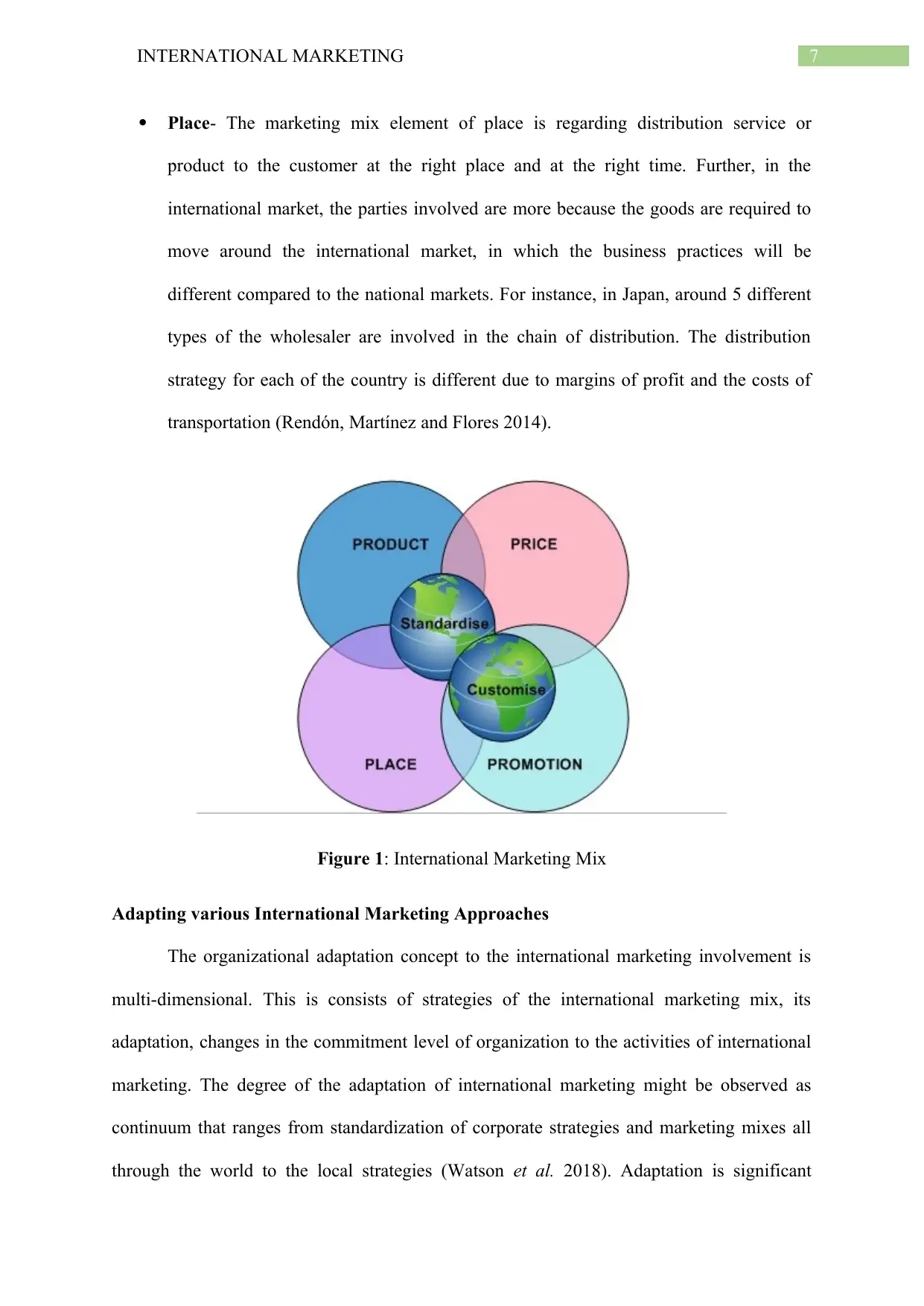
7INTERNATIONAL MARKETING
Place- The marketing mix element of place is regarding distribution service or
product to the customer at the right place and at the right time. Further, in the
international market, the parties involved are more because the goods are required to
move around the international market, in which the business practices will be
different compared to the national markets. For instance, in Japan, around 5 different
types of the wholesaler are involved in the chain of distribution. The distribution
strategy for each of the country is different due to margins of profit and the costs of
transportation (Rendón, Martínez and Flores 2014).
Figure 1: International Marketing Mix
Adapting various International Marketing Approaches
The organizational adaptation concept to the international marketing involvement is
multi-dimensional. This is consists of strategies of the international marketing mix, its
adaptation, changes in the commitment level of organization to the activities of international
marketing. The degree of the adaptation of international marketing might be observed as
continuum that ranges from standardization of corporate strategies and marketing mixes all
through the world to the local strategies (Watson et al. 2018). Adaptation is significant
Place- The marketing mix element of place is regarding distribution service or
product to the customer at the right place and at the right time. Further, in the
international market, the parties involved are more because the goods are required to
move around the international market, in which the business practices will be
different compared to the national markets. For instance, in Japan, around 5 different
types of the wholesaler are involved in the chain of distribution. The distribution
strategy for each of the country is different due to margins of profit and the costs of
transportation (Rendón, Martínez and Flores 2014).
Figure 1: International Marketing Mix
Adapting various International Marketing Approaches
The organizational adaptation concept to the international marketing involvement is
multi-dimensional. This is consists of strategies of the international marketing mix, its
adaptation, changes in the commitment level of organization to the activities of international
marketing. The degree of the adaptation of international marketing might be observed as
continuum that ranges from standardization of corporate strategies and marketing mixes all
through the world to the local strategies (Watson et al. 2018). Adaptation is significant
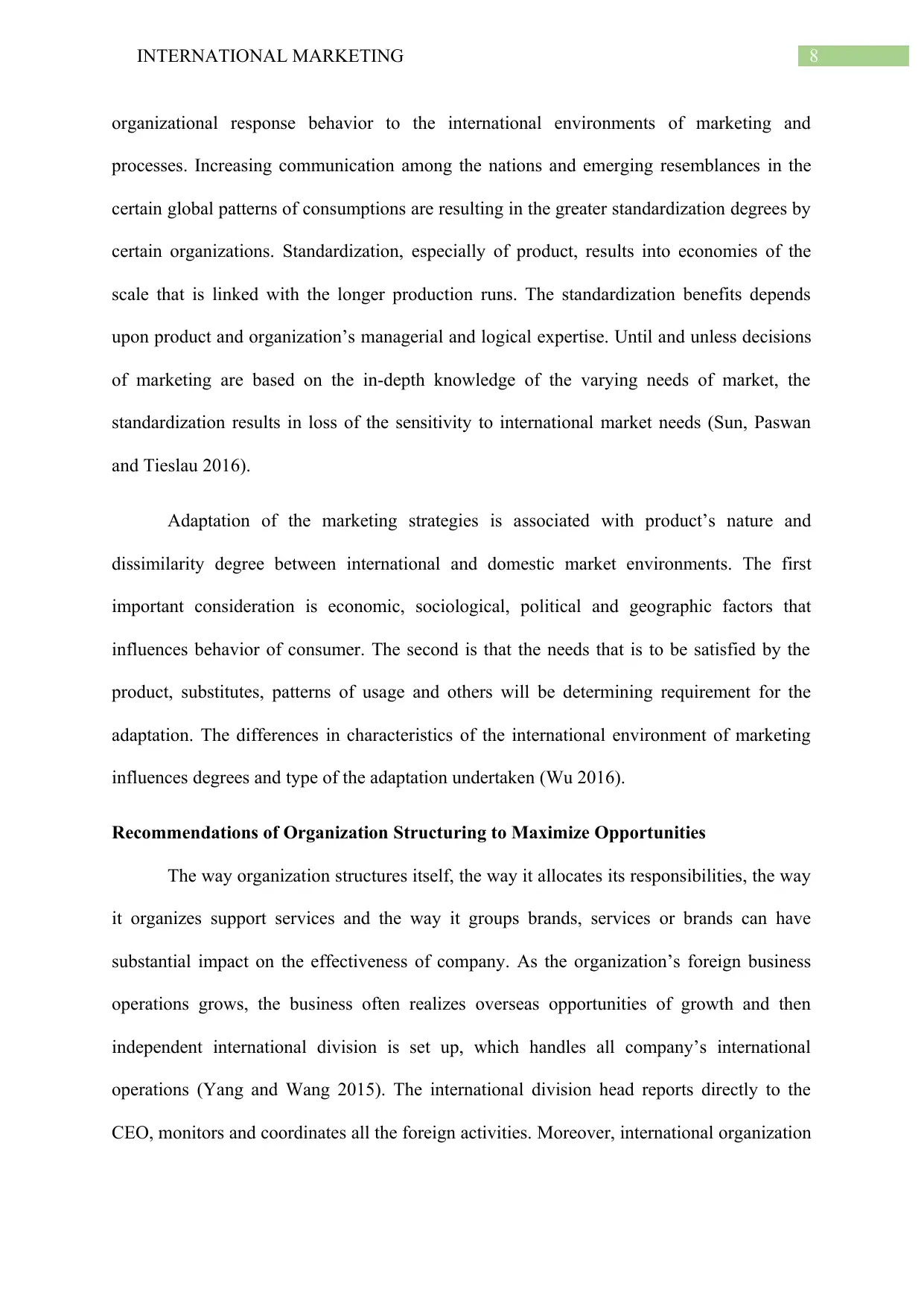
8INTERNATIONAL MARKETING
organizational response behavior to the international environments of marketing and
processes. Increasing communication among the nations and emerging resemblances in the
certain global patterns of consumptions are resulting in the greater standardization degrees by
certain organizations. Standardization, especially of product, results into economies of the
scale that is linked with the longer production runs. The standardization benefits depends
upon product and organization’s managerial and logical expertise. Until and unless decisions
of marketing are based on the in-depth knowledge of the varying needs of market, the
standardization results in loss of the sensitivity to international market needs (Sun, Paswan
and Tieslau 2016).
Adaptation of the marketing strategies is associated with product’s nature and
dissimilarity degree between international and domestic market environments. The first
important consideration is economic, sociological, political and geographic factors that
influences behavior of consumer. The second is that the needs that is to be satisfied by the
product, substitutes, patterns of usage and others will be determining requirement for the
adaptation. The differences in characteristics of the international environment of marketing
influences degrees and type of the adaptation undertaken (Wu 2016).
Recommendations of Organization Structuring to Maximize Opportunities
The way organization structures itself, the way it allocates its responsibilities, the way
it organizes support services and the way it groups brands, services or brands can have
substantial impact on the effectiveness of company. As the organization’s foreign business
operations grows, the business often realizes overseas opportunities of growth and then
independent international division is set up, which handles all company’s international
operations (Yang and Wang 2015). The international division head reports directly to the
CEO, monitors and coordinates all the foreign activities. Moreover, international organization
organizational response behavior to the international environments of marketing and
processes. Increasing communication among the nations and emerging resemblances in the
certain global patterns of consumptions are resulting in the greater standardization degrees by
certain organizations. Standardization, especially of product, results into economies of the
scale that is linked with the longer production runs. The standardization benefits depends
upon product and organization’s managerial and logical expertise. Until and unless decisions
of marketing are based on the in-depth knowledge of the varying needs of market, the
standardization results in loss of the sensitivity to international market needs (Sun, Paswan
and Tieslau 2016).
Adaptation of the marketing strategies is associated with product’s nature and
dissimilarity degree between international and domestic market environments. The first
important consideration is economic, sociological, political and geographic factors that
influences behavior of consumer. The second is that the needs that is to be satisfied by the
product, substitutes, patterns of usage and others will be determining requirement for the
adaptation. The differences in characteristics of the international environment of marketing
influences degrees and type of the adaptation undertaken (Wu 2016).
Recommendations of Organization Structuring to Maximize Opportunities
The way organization structures itself, the way it allocates its responsibilities, the way
it organizes support services and the way it groups brands, services or brands can have
substantial impact on the effectiveness of company. As the organization’s foreign business
operations grows, the business often realizes overseas opportunities of growth and then
independent international division is set up, which handles all company’s international
operations (Yang and Wang 2015). The international division head reports directly to the
CEO, monitors and coordinates all the foreign activities. Moreover, international organization
⊘ This is a preview!⊘
Do you want full access?
Subscribe today to unlock all pages.

Trusted by 1+ million students worldwide
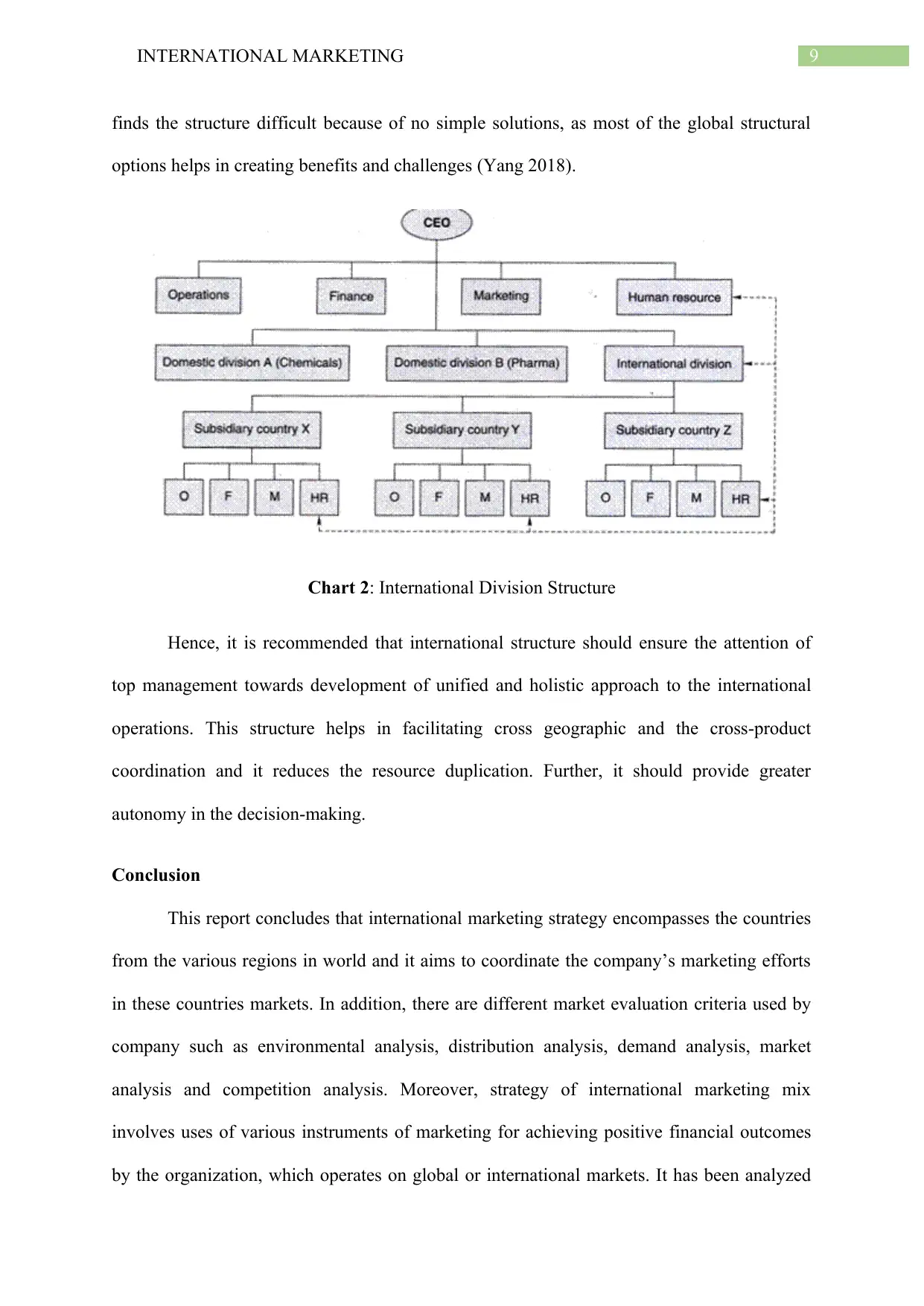
9INTERNATIONAL MARKETING
finds the structure difficult because of no simple solutions, as most of the global structural
options helps in creating benefits and challenges (Yang 2018).
Chart 2: International Division Structure
Hence, it is recommended that international structure should ensure the attention of
top management towards development of unified and holistic approach to the international
operations. This structure helps in facilitating cross geographic and the cross-product
coordination and it reduces the resource duplication. Further, it should provide greater
autonomy in the decision-making.
Conclusion
This report concludes that international marketing strategy encompasses the countries
from the various regions in world and it aims to coordinate the company’s marketing efforts
in these countries markets. In addition, there are different market evaluation criteria used by
company such as environmental analysis, distribution analysis, demand analysis, market
analysis and competition analysis. Moreover, strategy of international marketing mix
involves uses of various instruments of marketing for achieving positive financial outcomes
by the organization, which operates on global or international markets. It has been analyzed
finds the structure difficult because of no simple solutions, as most of the global structural
options helps in creating benefits and challenges (Yang 2018).
Chart 2: International Division Structure
Hence, it is recommended that international structure should ensure the attention of
top management towards development of unified and holistic approach to the international
operations. This structure helps in facilitating cross geographic and the cross-product
coordination and it reduces the resource duplication. Further, it should provide greater
autonomy in the decision-making.
Conclusion
This report concludes that international marketing strategy encompasses the countries
from the various regions in world and it aims to coordinate the company’s marketing efforts
in these countries markets. In addition, there are different market evaluation criteria used by
company such as environmental analysis, distribution analysis, demand analysis, market
analysis and competition analysis. Moreover, strategy of international marketing mix
involves uses of various instruments of marketing for achieving positive financial outcomes
by the organization, which operates on global or international markets. It has been analyzed
Paraphrase This Document
Need a fresh take? Get an instant paraphrase of this document with our AI Paraphraser
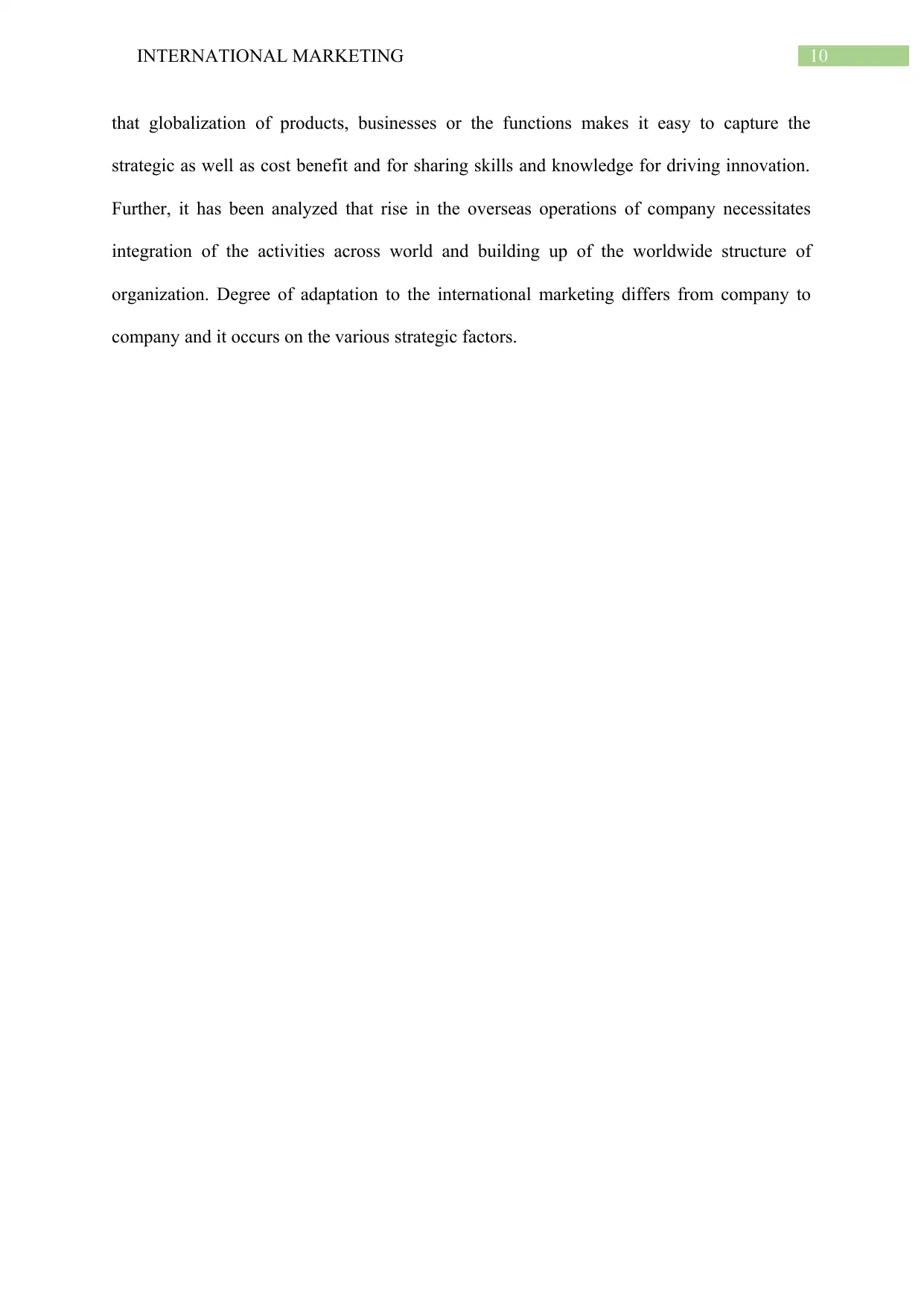
10INTERNATIONAL MARKETING
that globalization of products, businesses or the functions makes it easy to capture the
strategic as well as cost benefit and for sharing skills and knowledge for driving innovation.
Further, it has been analyzed that rise in the overseas operations of company necessitates
integration of the activities across world and building up of the worldwide structure of
organization. Degree of adaptation to the international marketing differs from company to
company and it occurs on the various strategic factors.
that globalization of products, businesses or the functions makes it easy to capture the
strategic as well as cost benefit and for sharing skills and knowledge for driving innovation.
Further, it has been analyzed that rise in the overseas operations of company necessitates
integration of the activities across world and building up of the worldwide structure of
organization. Degree of adaptation to the international marketing differs from company to
company and it occurs on the various strategic factors.
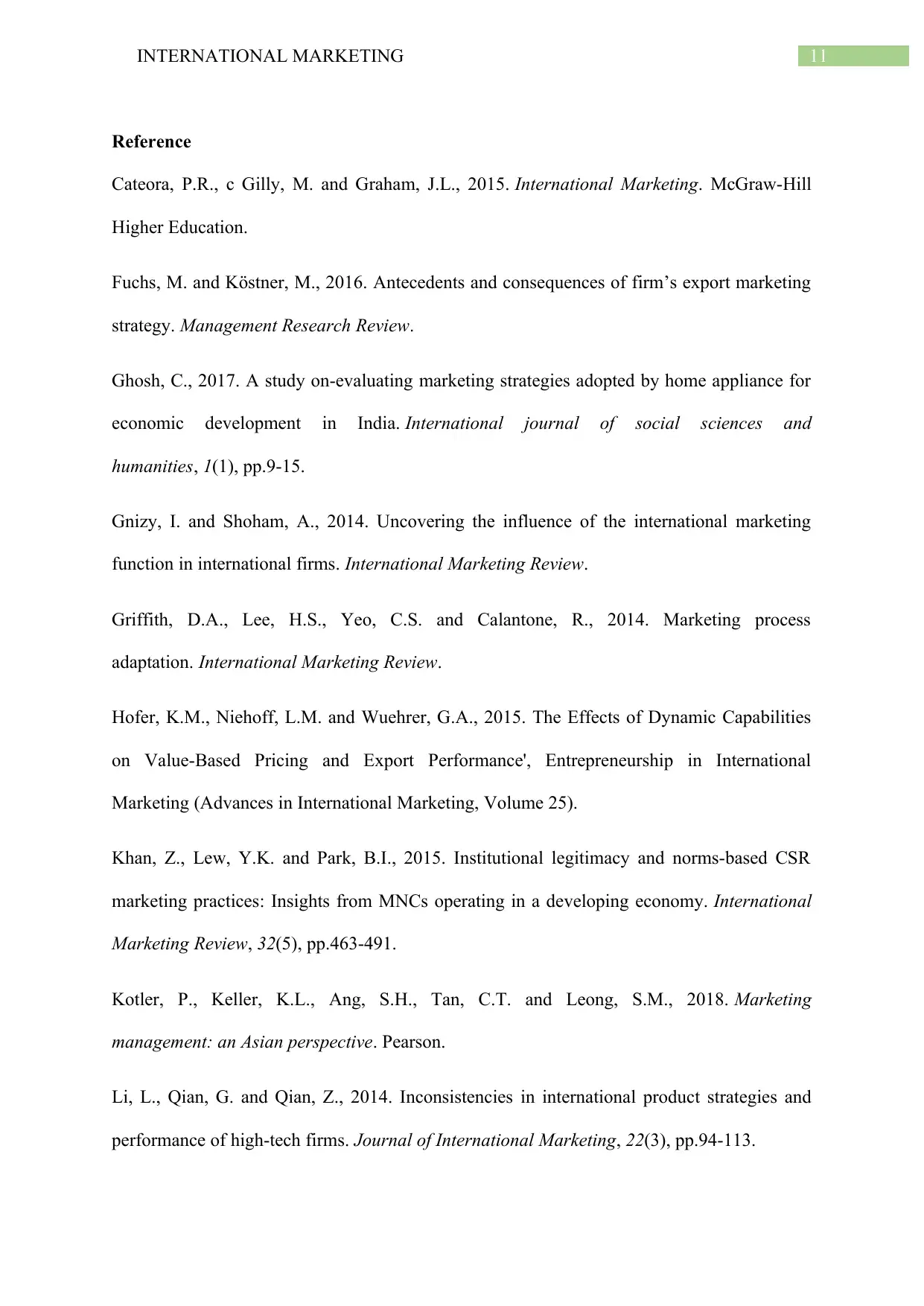
11INTERNATIONAL MARKETING
Reference
Cateora, P.R., c Gilly, M. and Graham, J.L., 2015. International Marketing. McGraw-Hill
Higher Education.
Fuchs, M. and Köstner, M., 2016. Antecedents and consequences of firm’s export marketing
strategy. Management Research Review.
Ghosh, C., 2017. A study on-evaluating marketing strategies adopted by home appliance for
economic development in India. International journal of social sciences and
humanities, 1(1), pp.9-15.
Gnizy, I. and Shoham, A., 2014. Uncovering the influence of the international marketing
function in international firms. International Marketing Review.
Griffith, D.A., Lee, H.S., Yeo, C.S. and Calantone, R., 2014. Marketing process
adaptation. International Marketing Review.
Hofer, K.M., Niehoff, L.M. and Wuehrer, G.A., 2015. The Effects of Dynamic Capabilities
on Value-Based Pricing and Export Performance', Entrepreneurship in International
Marketing (Advances in International Marketing, Volume 25).
Khan, Z., Lew, Y.K. and Park, B.I., 2015. Institutional legitimacy and norms-based CSR
marketing practices: Insights from MNCs operating in a developing economy. International
Marketing Review, 32(5), pp.463-491.
Kotler, P., Keller, K.L., Ang, S.H., Tan, C.T. and Leong, S.M., 2018. Marketing
management: an Asian perspective. Pearson.
Li, L., Qian, G. and Qian, Z., 2014. Inconsistencies in international product strategies and
performance of high-tech firms. Journal of International Marketing, 22(3), pp.94-113.
Reference
Cateora, P.R., c Gilly, M. and Graham, J.L., 2015. International Marketing. McGraw-Hill
Higher Education.
Fuchs, M. and Köstner, M., 2016. Antecedents and consequences of firm’s export marketing
strategy. Management Research Review.
Ghosh, C., 2017. A study on-evaluating marketing strategies adopted by home appliance for
economic development in India. International journal of social sciences and
humanities, 1(1), pp.9-15.
Gnizy, I. and Shoham, A., 2014. Uncovering the influence of the international marketing
function in international firms. International Marketing Review.
Griffith, D.A., Lee, H.S., Yeo, C.S. and Calantone, R., 2014. Marketing process
adaptation. International Marketing Review.
Hofer, K.M., Niehoff, L.M. and Wuehrer, G.A., 2015. The Effects of Dynamic Capabilities
on Value-Based Pricing and Export Performance', Entrepreneurship in International
Marketing (Advances in International Marketing, Volume 25).
Khan, Z., Lew, Y.K. and Park, B.I., 2015. Institutional legitimacy and norms-based CSR
marketing practices: Insights from MNCs operating in a developing economy. International
Marketing Review, 32(5), pp.463-491.
Kotler, P., Keller, K.L., Ang, S.H., Tan, C.T. and Leong, S.M., 2018. Marketing
management: an Asian perspective. Pearson.
Li, L., Qian, G. and Qian, Z., 2014. Inconsistencies in international product strategies and
performance of high-tech firms. Journal of International Marketing, 22(3), pp.94-113.
⊘ This is a preview!⊘
Do you want full access?
Subscribe today to unlock all pages.

Trusted by 1+ million students worldwide
1 out of 14
Related Documents
Your All-in-One AI-Powered Toolkit for Academic Success.
+13062052269
info@desklib.com
Available 24*7 on WhatsApp / Email
![[object Object]](/_next/static/media/star-bottom.7253800d.svg)
Unlock your academic potential
Copyright © 2020–2025 A2Z Services. All Rights Reserved. Developed and managed by ZUCOL.





